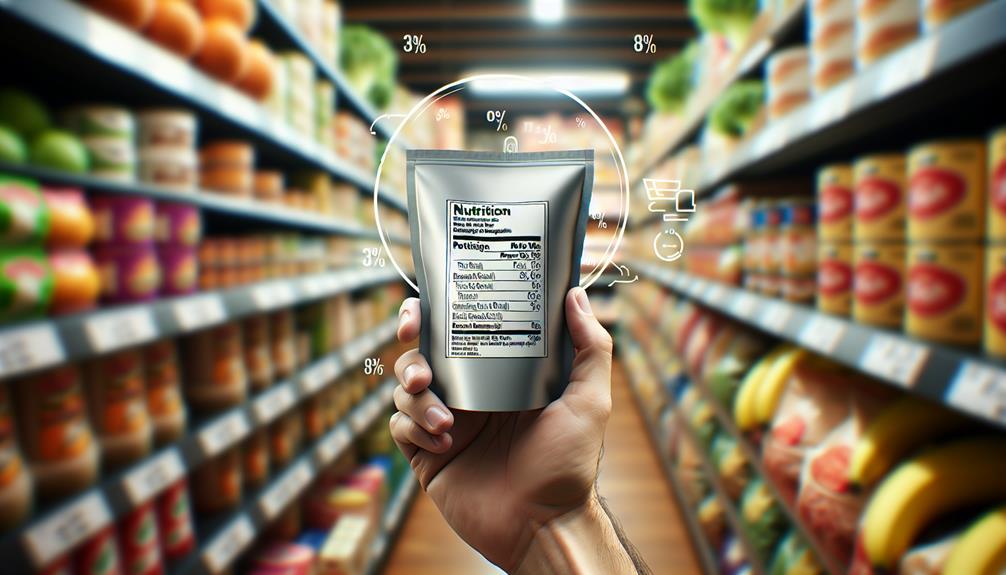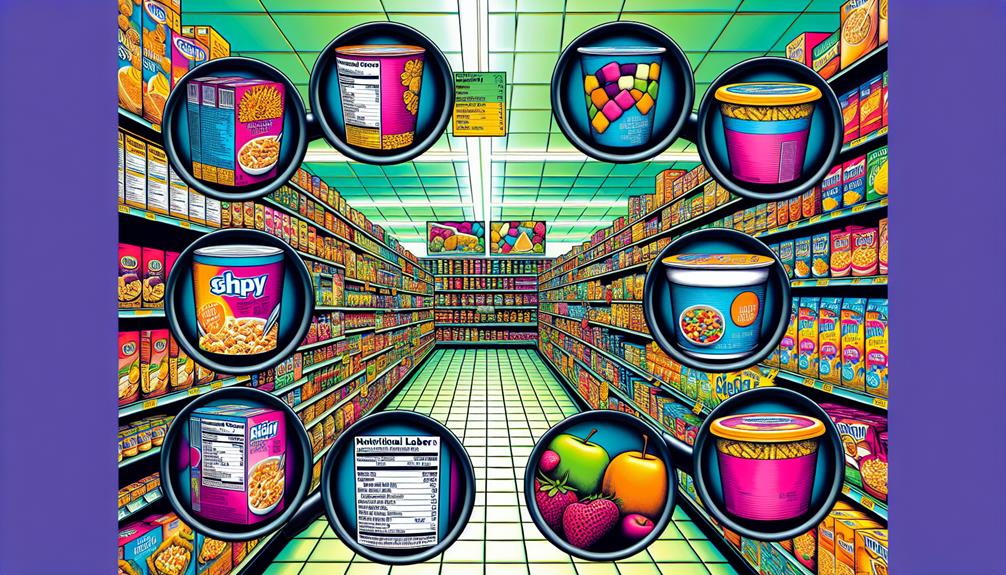Are you tired of feeling overwhelmed when you stroll down the grocery aisles, bombarded by a sea of nutrition labels? It's no secret that deciphering these labels can be a daunting task. But fear not, because in this discussion, we will unravel the mysteries behind nutrition labels and equip you with the knowledge to make informed choices for your health. From understanding serving sizes to deciphering % Daily Values and unraveling ingredient lists, we will delve into the key nutrients to look out for and how to spot hidden sugars and additives. So, if you're ready to take control of your grocery shopping experience, keep reading to navigate the aisles like a pro.
Key Takeaways
- Serving sizes on food labels are standardized measurements and may not be the same as the amount to eat in one sitting.
- Pay attention to key nutrients like fiber and sodium intake to support a healthy digestive system and reduce the risk of high blood pressure and heart disease.
- % Daily Values on nutrition labels represent the recommended daily intake of specific nutrients, such as fat, sodium, carbohydrates, protein, and fiber.
- Ingredient lists are important for determining the quality and nutritional value of a product, so aim for products with whole, recognizable ingredients and be cautious of hidden sources of added sugars and unhealthy fats.
Understanding Serving Sizes
Understanding serving sizes is crucial for making informed decisions about your nutrition. When it comes to portions, it's easy to get confused. But fear not, because here's everything you need to know about serving sizes and portion control.
Firstly, let's tackle the concept of serving sizes. Serving sizes are standardized measurements that help you understand how much of a particular food constitutes one serving. They are usually listed on food labels and can vary depending on the product. Keep in mind that serving sizes are not necessarily the same as the amount you should eat in one sitting. They are simply a reference point for comparing nutritional information.
To manage your portion sizes effectively, consider these portion control tips. Start by using smaller plates and bowls to help visually reduce the amount of food you consume. Be mindful of your hunger and fullness cues to prevent overeating. Additionally, try to avoid eating directly from the package, as this can make it difficult to gauge proper portion sizes.
Portion control is vital for maintaining a healthy weight and meeting your nutritional needs. By understanding serving sizes and implementing portion control strategies, you can make better choices for your overall health and well-being.
Key Nutrients to Look Out For
When evaluating nutrition labels, it is important to be aware of the key nutrients to look out for. Two of these important nutrients are fiber and sodium.
Fiber is an essential nutrient that plays a crucial role in maintaining a healthy digestive system. It helps regulate bowel movements, lowers cholesterol levels, and controls blood sugar levels. To ensure you are getting enough fiber, aim for a daily intake of at least 25 grams for women and 38 grams for men.
On the other hand, sodium is a nutrient that should be consumed in moderation. While our bodies need some sodium for proper functioning, excessive sodium intake can increase the risk of high blood pressure and heart disease. The American Heart Association recommends limiting sodium intake to no more than 2,300 milligrams per day, but ideally, aiming for less than 1,500 milligrams is even better.
When reading nutrition labels, pay attention to the amount of fiber and sodium in the product. Look for foods that are high in fiber and low in sodium to support a healthy diet. Incorporating more fruits, vegetables, whole grains, and lean proteins into your meals can help increase fiber intake while reducing sodium levels.
Deciphering % Daily Values

To further understand the nutritional content of a food product, it is important to decipher the % Daily Values listed on the nutrition label. These values represent the percentage of recommended daily intake of specific nutrients based on a 2,000-calorie diet. Here's how to interpret them:
- Fat: The daily value for fat is based on a maximum intake of 78 grams. If a food item has 15% of the daily value for fat, it means it provides 15% of the recommended daily intake of fat.
- Sodium: The daily value for sodium is 2,300 milligrams. If a food item has 10% of the daily value for sodium, it means it provides 10% of the recommended daily intake of sodium.
- Carbohydrates: The daily value for carbohydrates is 300 grams. If a food item has 20% of the daily value for carbohydrates, it means it provides 20% of the recommended daily intake of carbohydrates.
- Protein: The daily value for protein is 50 grams. If a food item has 25% of the daily value for protein, it means it provides 25% of the recommended daily intake of protein.
- Fiber: The daily value for fiber is 25 grams. If a food item has 30% of the daily value for fiber, it means it provides 30% of the recommended daily intake of fiber.
Unraveling Ingredient Lists
Now let's delve into the intricacies of decoding ingredient lists. When it comes to reading labels, understanding the ingredient list is essential for making informed food choices. Ingredient analysis allows you to determine the quality and nutritional value of a product. Start by looking for the first few ingredients, as they make up the majority of the product. Ingredients are listed in descending order by weight, so the first few ingredients are the most important. Aim for products with whole, recognizable ingredients rather than those with long, complicated names or additives. Be cautious of ingredients like high-fructose corn syrup, artificial colors, and preservatives, as they have been linked to various health issues. Additionally, watch out for hidden sources of added sugars and unhealthy fats. Familiarize yourself with common names for sugar, such as sucrose, fructose, and corn syrup, and be aware of unhealthy fats like hydrogenated oils. By analyzing the ingredient list, you can make informed choices that align with your dietary goals and preferences.
Spotting Hidden Sugars and Additives

Understanding the ingredient list is crucial for making informed food choices, especially when it comes to spotting hidden sugars and additives. Here are some tips to help you navigate through the grocery aisles and identify these hidden ingredients:
- Look out for alternative names for sugar: Sugar can hide under various names such as high fructose corn syrup, dextrose, sucrose, and maltose. Be mindful of these terms and their placement on the ingredient list.
- Substituting artificial sweeteners: While artificial sweeteners may seem like a healthier alternative to sugar, they can have their own set of drawbacks. Look for ingredients like aspartame, sucralose, and saccharin if you want to avoid them.
- Identifying common food additives: Food additives can enhance the flavor, texture, and appearance of processed foods, but they can also have negative effects on your health. Keep an eye out for ingredients like monosodium glutamate (MSG), artificial colors (such as Red 40 or Yellow 5), and preservatives (such as BHA or BHT).
Making Informed Choices for Your Health
When making choices for your health, it is important to be well-informed about the nutritional content of the foods you consume. Reading nutrition labels can provide you with valuable information to help you make informed decisions. One of the key benefits of reading nutrition labels is that it allows you to practice portion control. By understanding the serving size and the number of servings per container, you can better manage your calorie intake and avoid overeating.
In addition to portion control, nutrition labels also provide information about the nutrients and ingredients in a food product. This can help you identify foods that are high in nutrients and low in unhealthy additives. For example, by checking the saturated fat and sodium content, you can choose products that are healthier for your heart.
To illustrate the importance of reading nutrition labels, here is a table highlighting the key nutrients to look for and limit:
| Nutrients to Look for | Nutrients to Limit |
|---|---|
| Fiber | Saturated Fat |
| Protein | Trans Fat |
| Vitamins and Minerals | Sodium |
| Antioxidants | Added Sugars |
Frequently Asked Questions
Can I Rely Solely on the % Daily Values to Determine if a Product Is Healthy for Me?
You can't rely solely on % daily values to determine if a product is healthy for you. While they provide a rough estimate, they have limitations and don't account for individual needs or the quality of ingredients.
How Do I Know if a Product Contains Hidden Sugars or Additives?
To identify hidden sugars or additives in a product, examine the ingredients list. Look for terms like high fructose corn syrup, maltodextrin, or artificial flavors. Remember, a closer look can reveal the truth.
Are There Any Specific Ingredients I Should Avoid When Reading Ingredient Lists?
When reading ingredient lists, avoid harmful ingredients like artificial sweeteners, high fructose corn syrup, and hydrogenated oils. Look for healthier substitutes such as natural sweeteners, whole grains, and plant-based oils to make better choices for your health.
Is It Important to Pay Attention to the Serving Size on Nutrition Labels?
It's important to pay attention to the serving size on nutrition labels because it helps you understand portion control. By knowing the serving size, you can make informed choices about the nutrient density of the food you're consuming.
What Are Some Tips for Making Healthier Choices When Grocery Shopping?
When grocery shopping, use these tips for choosing nutritious foods: read labels, compare products, choose whole foods, limit added sugars, opt for lean proteins, and include plenty of fruits and vegetables. Smart shopping strategies lead to healthier choices.
Conclusion
In conclusion, navigating the grocery aisles can be overwhelming, but understanding nutrition labels is key to making informed choices for your health. By decoding serving sizes, key nutrients, % daily values, and ingredient lists, you can spot hidden sugars and additives. Remember, knowledge is power, and armed with this information, you can confidently fill your cart with nutritious options that support your well-being. So, next time you hit the store, let your appetite for knowledge guide you to a healthier lifestyle.













